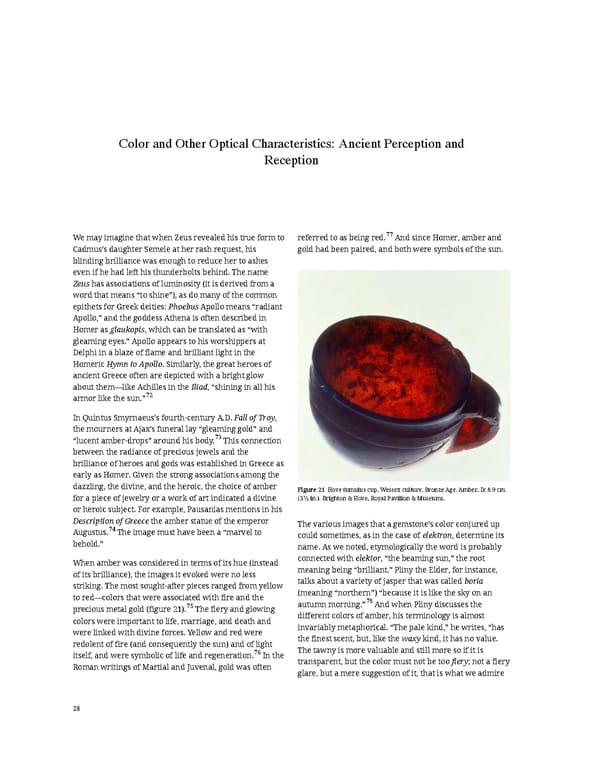Color and Other Optical Characteristics: Ancient Perception and Reception We may imagine that when Zeus revealed his true form to referred to as being red.77 And since Homer, amber and Cadmus’s daughter Semele at her rash request, his gold had been paired, and both were symbols of the sun. blinding brilliance was enough to reduce her to ashes even if he had left his thunderbolts behind. The name Zeushas associations of luminosity (it is derived from a word that means “to shine”), as do many of the common epithets for Greek deities: Phoebus Apollo means “radiant Apollo,” and the goddess Athena is often described in Homer asglaukopis, which can be translated as “with gleaming eyes.” Apollo appears to his worshippers at Delphi in a blaze of flame and brilliant light in the HomericHymn to Apollo. Similarly, the great heroes of ancient Greece often are depicted with a bright glow about them—like Achilles in the Iliad, “shining in all his armor like the sun.”72 In Quintus Smyrnaeus’s fourth-century A.D. Fall of Troy, the mourners at Ajax’s funeral lay “gleaming gold” and “lucent amber-drops” around his body.73 This connection between the radiance of precious jewels and the brilliance of heroes and gods was established in Greece as early as Homer. Given the strong associations among the dazzling, the divine, and the heroic, the choice of amber Figure 21 Hove tumulus cup, Wessex culture, Bronze Age. Amber, D: 8.9 cm for a piece of jewelry or a work of art indicated a divine (31⁄2 in.). Brighton & Hove, Royal Pavilion & Museums. or heroic subject. For example, Pausanias mentions in his Description of Greece the amber statue of the emperor The various images that a gemstone’s color conjured up Augustus.74 The image must have been a “marvel to could sometimes, as in the case of elektron, determine its behold.” name. As we noted, etymologically the word is probably When amber was considered in terms of its hue (instead connected with elektor, “the beaming sun,” the root of its brilliance), the images it evoked were no less meaning being “brilliant.” Pliny the Elder, for instance, striking. The most sought-after pieces ranged from yellow talks about a variety of jasper that was called boria to red—colors that were associated with fire and the (meaning “northern”) “because it is like the sky on an 75 autumn morning.”78And when Pliny discusses the precious metal gold (figure 21). The fiery and glowing different colors of amber, his terminology is almost colors were important to life, marriage, and death and invariably metaphorical. “The pale kind,” he writes, “has were linked with divine forces. Yellow and red were the finest scent, but, like the waxy kind, it has no value. redolent of fire (and consequently the sun) and of light The tawny is more valuable and still more so if it is itself, and were symbolic of life and regeneration.76 In the Roman writings of Martial and Juvenal, gold was often transparent, but the color must not be too fiery; not a fiery glare, but a mere suggestion of it, that is what we admire 28
 Ancient Carved Ambers in the J. Paul Getty Museum Page 37 Page 39
Ancient Carved Ambers in the J. Paul Getty Museum Page 37 Page 39
